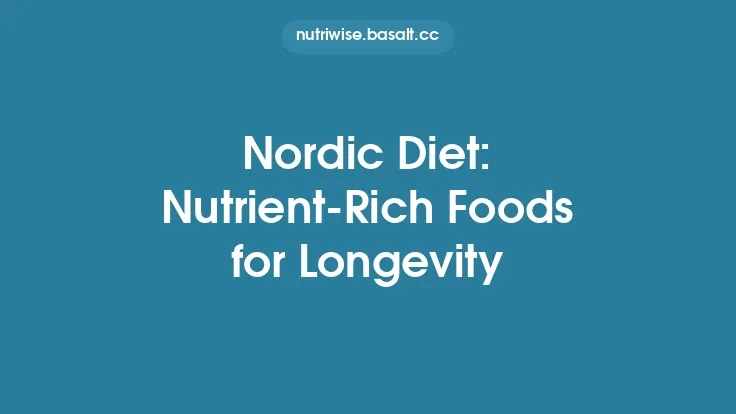Micronutrient density is a concept that goes beyond the simple tally of vitamins and minerals on a nutrition label. It asks a more fundamental question: how much essential micronutrient value does a given amount of food deliver relative to the energy, volume, or weight you consume? Understanding this relationship equips anyone—from the casual home cook to the health‑focused professional—with a scientific lens for selecting foods that truly nourish the body, rather than merely filling the stomach.
Defining Micronutrient Density
At its core, micronutrient density measures the concentration of vitamins, minerals, and other essential trace compounds (such as iodine, selenium, and certain phytonutrients) per unit of a reference metric—most commonly per 100 kcal, per gram, or per serving size. Two foods can provide the same absolute amount of a nutrient, yet differ dramatically in density if one supplies it with far fewer calories or a smaller portion.
- High‑density example: 30 g of dried seaweed may deliver 200 % of the daily value (DV) for iodine while contributing only 30 kcal.
- Low‑density example: 200 g of a sugary beverage might provide the same 200 % DV for iodine (through fortification) but adds 300 kcal and little else.
The principle is analogous to “nutrient‑rich” versus “energy‑rich” foods. A micronutrient‑dense food maximizes the ratio of essential micronutrients to non‑essential components (empty calories, added sugars, refined starches).
Quantifying Micronutrient Density: Methods and Metrics
Several scientific frameworks have been developed to translate raw nutrient data into a single, comparable score. While each has its nuances, they share a common goal: to rank foods based on how efficiently they deliver micronutrients.
| Metric | Basis | Typical Calculation | Strengths |
|---|---|---|---|
| Nutrient Rich Food Index (NRF) | Sum of %DV for selected nutrients – subtracts %DV for nutrients to limit | NRF = ∑(positive nutrients) – ∑(negative nutrients) per 100 kcal | Balances beneficial and adverse nutrients |
| Aggregate Nutrient Density Index (ANDI) | Weighted sum of 17 micronutrients per 100 g | ANDI score = Σ (nutrient content × weighting factor) | Simple, widely recognized in consumer media |
| Micronutrient Density Ratio (MDR) | Micronutrient content per gram of food | MDR = (Σ micronutrient amounts) / weight (g) | Directly reflects concentration, independent of calories |
| Nutrient Density Score (NDS) | Micronutrients per 100 kcal, adjusted for bioavailability | NDS = Σ (bioavailable nutrient × DV factor) / 100 kcal | Incorporates absorption considerations |
When applying any metric, it is crucial to:
- Select the nutrient set relevant to the target population (e.g., iron and folate for women of childbearing age).
- Determine weighting based on public health priorities (e.g., higher weight for vitamin D in regions with limited sunlight).
- Normalize to a common denominator (calories, weight, or serving) to enable apples‑to‑apples comparisons.
Factors That Influence Micronutrient Content in Foods
Micronutrient density is not a static property; it fluctuates according to a host of agricultural, environmental, and processing variables.
1. Soil Quality and Fertility
- Mineral availability in the soil directly impacts the mineral content of plant foods. Soils deficient in magnesium, zinc, or selenium produce crops with lower corresponding levels.
- Organic matter and pH influence the uptake of micronutrients; for instance, acidic soils enhance iron solubility, potentially raising iron content in root vegetables.
2. Plant Variety and Genetics
- Heirloom vs. modern cultivars can differ markedly. Some heritage varieties have been bred for flavor and nutrient richness, whereas many high‑yield commercial lines prioritize size and shelf‑life.
- Biofortified strains (e.g., orange-fleshed sweet potatoes rich in β‑carotene) intentionally increase specific micronutrients.
3. Harvest Timing
- Maturity stage matters. Early‑harvest greens may retain higher levels of vitamin C, while fully ripened fruits often accumulate more provitamin A carotenoids.
- Post‑harvest interval: Nutrient degradation begins soon after picking; prolonged storage can diminish water‑soluble vitamins.
4. Processing and Refinement
- Mechanical removal (e.g., polishing rice) strips bran and germ, which house the bulk of B‑vitamins and minerals.
- Thermal treatments can both destroy and liberate nutrients: boiling may leach water‑soluble vitamins, yet cooking tomatoes increases lycopene bioavailability.
5. Fortification and Enrichment
- While fortification can boost micronutrient density artificially, it does not always reflect the natural nutrient profile and may not account for bioavailability differences.
Bioavailability: The Bridge Between Content and Utilization
A food’s measured micronutrient content is only part of the story; the body’s ability to absorb and use those nutrients determines true nutritional value.
1. Chemical Form
- Iron: Heme iron (from animal sources) is absorbed at 15‑35 % efficiency, whereas non‑heme iron (plant sources) averages 2‑20 % and is highly influenced by dietary enhancers and inhibitors.
- Calcium: Calcium carbonate requires an acidic environment for optimal absorption, while calcium citrate is more readily absorbed regardless of stomach acidity.
2. Food Matrix Effects
- Phytates (found in legumes, whole grains, nuts) bind minerals like zinc and iron, reducing their absorption.
- Oxalates (in spinach, rhubarb) can chelate calcium, limiting its bioavailability.
- Fiber: Soluble fiber may slow nutrient transit, potentially enhancing absorption of certain minerals, whereas insoluble fiber can accelerate passage and reduce contact time.
3. Enhancers and Inhibitors
- Vitamin C dramatically improves non‑heme iron absorption by reducing ferric to ferrous iron.
- Vitamin D upregulates calcium transport proteins, increasing calcium uptake.
- Polyphenols (e.g., tannins in tea) can inhibit iron absorption, while certain fatty acids aid the absorption of fat‑soluble vitamins (A, D, E, K).
4. Individual Physiological Factors
- Gastrointestinal health (e.g., presence of celiac disease) can impair nutrient absorption.
- Age: Elderly individuals often have reduced gastric acid secretion, affecting mineral solubility.
- Medication interactions: Proton‑pump inhibitors, antacids, and certain antibiotics can interfere with micronutrient uptake.
Understanding these dynamics is essential when evaluating foods for “maximum nutrient value.” A food high in a given micronutrient may still be a poor source if the nutrient is locked within an indigestible matrix.
Using Nutrient Databases and Tools to Compare Foods
Modern nutrition science offers robust, publicly accessible resources that allow precise micronutrient density calculations:
- USDA FoodData Central – Provides comprehensive nutrient profiles, including raw, cooked, and processed forms. The “Standard Reference” tables list micronutrient values per 100 g, facilitating MDR calculations.
- EuroFIR FoodEXplorer – European database with detailed micronutrient data, including bioavailability modifiers for certain foods.
- FAO/INFOODS Food Composition Database – Global coverage, useful for comparing foods across regions.
- Mobile Apps (e.g., Cronometer, MyFitnessPal) – Offer quick nutrient breakdowns and can export data for custom density analysis.
When using these tools, follow a systematic workflow:
- Select a reference unit (e.g., per 100 kcal) that aligns with your dietary goals.
- Extract micronutrient values for the foods of interest.
- Apply weighting based on personal or population‑level nutrient priorities.
- Adjust for bioavailability using known enhancement or inhibition factors (e.g., multiply iron content by 0.15 for non‑heme iron if no vitamin C is present).
- Rank the foods according to the chosen metric (NRF, ANDI, MDR, etc.).
This data‑driven approach removes guesswork and grounds food selection in quantifiable evidence.
Strategic Food Selection for High Micronutrient Yield
Armed with an understanding of density metrics and bioavailability, you can adopt a strategic mindset when building meals:
- Prioritize foods with high micronutrient-to-calorie ratios
- Leafy greens, sea vegetables, organ meats, and certain nuts often deliver multiple vitamins/minerals with minimal caloric load.
- Combine complementary foods to boost absorption
- Pair iron‑rich legumes with vitamin C‑rich fruits or vegetables.
- Include a modest amount of healthy fat (e.g., olive oil, avocado) when consuming fat‑soluble vitamin sources like carrots or kale.
- Select minimally processed forms when possible
- Whole grains retain B‑vitamins and minerals that are lost in refined flours.
- Fresh or frozen vegetables preserve more water‑soluble vitamins than canned counterparts (unless the canning liquid is retained).
- Consider portion efficiency
- A small serving of dried seaweed can outpace a large serving of fortified cereal in iodine density.
- A tablespoon of nutritional yeast provides a concentrated source of B‑vitamins without excess calories.
- Leverage natural fortification
- Certain foods, such as mushrooms exposed to UV light, naturally increase vitamin D content, offering a high‑density source without synthetic additives.
By focusing on these principles, you can maximize the micronutrient return on each bite, regardless of dietary pattern (vegetarian, omnivorous, low‑carb, etc.).
Cooking, Processing, and Storage: Preserving Micronutrient Value
Even the most nutrient‑dense raw ingredient can lose its advantage if mishandled. Below are evidence‑based practices to safeguard micronutrient integrity:
| Process | Impact on Micronutrients | Best‑Practice Tips |
|---|---|---|
| Boiling | Leaches water‑soluble vitamins (C, B‑complex) into cooking water | Use minimal water; retain cooking liquid for soups or sauces |
| Steaming | Preserves >90 % of water‑soluble vitamins | Ideal for delicate greens and cruciferous vegetables |
| Microwaving | Short exposure time limits nutrient loss | Use a microwave‑safe cover to retain steam |
| Sautéing/Stir‑frying | Enhances absorption of fat‑soluble vitamins via added oil | Choose moderate heat; avoid burning |
| Roasting | Can concentrate nutrients by reducing water content, but high heat may degrade some vitamins | Roast at 180‑200 °C; monitor time to prevent charring |
| Freezing | Generally retains most nutrients; blanching before freezing can cause minor losses | Freeze quickly; store at ≤ -18 °C |
| Canning | Heat‑stable nutrients (e.g., lycopene) may increase; heat‑sensitive vitamins can decline | Choose “no‑salt added” or “low‑sugar” varieties; use the liquid as part of the dish |
| Drying/Dehydrating | Concentrates nutrients per gram but may degrade heat‑sensitive vitamins | Dry at low temperatures (< 60 °C) and protect from light |
Storage considerations: Light, oxygen, and temperature accelerate degradation of vitamins A, C, and some B‑vitamins. Store produce in cool, dark environments (e.g., a refrigerator crisper drawer) and consume within optimal windows (e.g., leafy greens within 3‑5 days).
Special Considerations: Age, Sex, Health Status, and Dietary Patterns
Micronutrient density is a universal concept, yet the *optimal* set of nutrients varies across life stages and physiological states.
- Children & Adolescents: Higher needs for calcium, iron, zinc, and B‑vitamins to support rapid growth and neurodevelopment. Foods with high calcium‑to‑phosphorus ratios (e.g., low‑fat dairy, fortified plant milks) become especially valuable.
- Pregnant & Lactating Women: Elevated requirements for folate, iron, iodine, and vitamin D. Selecting foods that deliver these nutrients in dense forms (e.g., lentils for folate, seaweed for iodine) can reduce reliance on supplements.
- Older Adults: Diminished gastric acid and altered gut microbiota affect absorption of B12, calcium, and iron. Nutrient‑dense foods paired with enhancers (e.g., vitamin C for iron) help mitigate deficits.
- Athletes & Highly Active Individuals: Increased turnover of electrolytes (magnesium, potassium) and antioxidants (vitamin C, selenium) necessitates foods that replenish these micronutrients without excessive caloric load.
- Vegetarian/Vegan Diets: Absence of heme iron and vitamin B12 requires careful selection of plant foods rich in non‑heme iron (legumes, seeds) and fortified products for B12. Attention to calcium‑rich plant sources (collard greens, fortified tofu) is also crucial.
Tailoring food choices to these specific needs ensures that the concept of “maximum nutrient value” translates into real health outcomes.
Common Pitfalls and Misconceptions
- “More is always better.”
Excessive intake of certain micronutrients (e.g., fat‑soluble vitamins A, D, E, K) can lead to toxicity. Density calculations should be balanced against upper intake limits.
- Equating fortification with natural density.
Fortified foods may score high on a density metric but often lack the synergistic phytochemicals present in whole foods, which can affect absorption and overall health.
- Relying solely on calorie‑based metrics.
For low‑calorie foods (e.g., cucumber), a per‑100‑kcal density may inflate scores despite negligible absolute nutrient amounts. Complementary per‑weight or per‑serving analyses provide a fuller picture.
- Ignoring the food matrix.
A high‑density raw ingredient may become low‑density after processing (e.g., refined white rice vs. brown rice). Always consider the final prepared form.
- Assuming all “superfoods” are universally superior.
Nutrient density is context‑dependent; a food that is dense in one micronutrient may be irrelevant for someone whose primary deficiency lies elsewhere.
Putting It All Together: A Framework for Choosing Nutrient‑Dense Foods
- Define Your Micronutrient Priorities
- Identify personal or population‑level gaps (e.g., iron, vitamin D).
- Assign weightings based on health goals and recommended dietary allowances.
- Select a Reference Metric
- Use per‑100 kcal for calorie‑controlled diets, or per‑gram for volume‑sensitive contexts.
- Gather Data
- Pull nutrient values from reputable databases (USDA, EuroFIR).
- Adjust for cooking method and storage losses using published retention factors.
- Apply Bioavailability Adjustments
- Multiply nutrient values by absorption coefficients (e.g., 0.15 for non‑heme iron without enhancers).
- Incorporate known enhancers/inhibitors present in the meal composition.
- Calculate a Composite Density Score
- Sum weighted, bioavailable nutrients and divide by the chosen reference unit.
- Rank foods and identify top performers for each priority nutrient.
- Integrate Practical Considerations
- Evaluate cost, accessibility, cultural acceptability, and culinary versatility.
- Choose foods that fit within realistic shopping and cooking routines.
- Iterate and Refine
- Track dietary intake and health markers (e.g., serum ferritin, 25‑OH vitamin D).
- Adjust weightings and food selections as needs evolve.
By following this systematic approach, you move from vague notions of “healthy foods” to a precise, data‑driven strategy that maximizes the micronutrient payoff of every meal.
In summary, micronutrient density is a powerful lens for evaluating food quality beyond calories or macronutrients. It demands an appreciation of raw nutrient content, the influence of agricultural and processing factors, the nuances of bioavailability, and the individual’s unique physiological context. Leveraging reliable databases, applying robust scoring methods, and respecting cooking and storage best practices enable anyone to choose foods that deliver the greatest possible micronutrient benefit—turning everyday meals into potent vehicles for optimal health.





